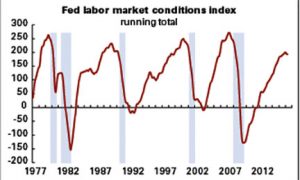As we’ve noted before, the end of QE is taking its toll on a variety of frothy markets—not just the unicorns in the Silicon Valley. The high-end condo market in Manhattan is cooling substantially; sales at the 1,004-foot tower known as One57 have stalled, with 20 of the 94 of the units still unsold, according to the Wall Street Journal. And One57 was a pioneer of the super-high-end segment; newcomers are finding it a rougher go. There’s no evidence—yet—that this slowdown is trickling down to more modest dwellings. There’s a massive construction boom underway in downtown Brooklyn and the neighboring “cultural district” around the Brooklyn Academy of Music, and a lesser one underway in Long Island City, Queens, both areas that were never known for luxury in the past. The transformation of both neighborhoods have been dreams of city planners since the late 1980s; it’s taken a few real estate cycles to get there. So far, demand has met supply, but if you walk around either area, you have to wonder how long their developers’ luck can hold out. During the mid-2000s housing boom, people seemed to forget that rising prices calls forth rising supply, which eventually puts an end to a bubble; will New Yorkers soon find out that the rules of the heartland apply to them as well?
But it’s not just the end of QE—there’s also the cooling in China and the end of the commodity boom, which is reducing the supply of restless capital looking for a home. A friend of TLR who does real estate banking in South Florida reports: “Construction lending is getting very tight, even for luxury condos in glamor markets. Russian, Latin and Mideast oligarch demand has evaporated, and the Chinese flight capital ain’t enough to bridge the gap. Likewise with hotels. Next shoe to drop is luxury rental market.”
In the Fed’s most recent survey of bank loan officers, there was a modest tightening of standards on commercial and industrial and commercial real estate loans—not as harsh as our Florida correspondent reports, but still a headwind for those sectors, though more a breeze than a gale. Standards on loans to households, by contrast, were modestly eased.




